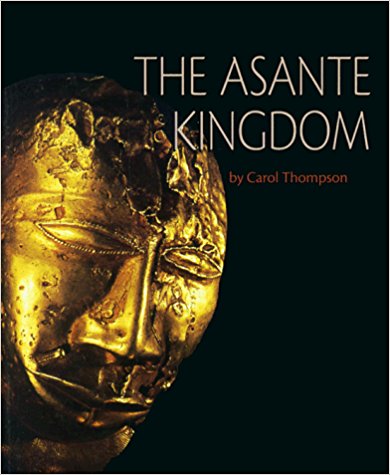Recommended Readings
Discovering the Asante Kingdom by Robert Z Cohen
 Based upon discoveries made possible by recent advances in research techniques, five of these six books discuss the history of sub-Saharan African kingdoms from about 800 CE to the 20th century. All, except Egyptian Dynasties, were located near the Gold and Ivory Coasts of Western Africa, and authors describe the origins, development, contributions, and eventual decline of each civilization. They emphasize how rulers and chiefs shaped each empire and its contributions to African culture. Most include information about the present and objectively discuss the historical and contemporary role of Islam in the region. Large, color photos of artifacts are a strong point, but the few maps that are included are either historical or lack detail. Additionally, some of the discussions of rulers and succession struggles are dry. Despite those weaknesses, the scarcity of material about this region makes these books suitable report purchases.
Based upon discoveries made possible by recent advances in research techniques, five of these six books discuss the history of sub-Saharan African kingdoms from about 800 CE to the 20th century. All, except Egyptian Dynasties, were located near the Gold and Ivory Coasts of Western Africa, and authors describe the origins, development, contributions, and eventual decline of each civilization. They emphasize how rulers and chiefs shaped each empire and its contributions to African culture. Most include information about the present and objectively discuss the historical and contemporary role of Islam in the region. Large, color photos of artifacts are a strong point, but the few maps that are included are either historical or lack detail. Additionally, some of the discussions of rulers and succession struggles are dry. Despite those weaknesses, the scarcity of material about this region makes these books suitable report purchases.
The Fall of the Asante Empire: The Hundred-Year War for Africa's Gold Coast by Robert Edgerton
 For the first time, anthropologist Robert Edgerton tells the story of the Hundred-Year War—from 1807 to 1900, between the British Empire and the Asante Kingdom—from the Asante point of view.
For the first time, anthropologist Robert Edgerton tells the story of the Hundred-Year War—from 1807 to 1900, between the British Empire and the Asante Kingdom—from the Asante point of view.
At its height, the Asante empire, on the Gold Coast of Africa in present-day Ghana, comprised three million people and had its own highly sophisticated social, political, and military institutions. Armed with European firearms, the tenacious and disciplined Asante army inflicted heavy casualties on advancing British troops, in some cases defeating them. They won the respect and admiration of British commanders, and displayed a unique willingness to adapt their traditional military tactics to counter superior British technology. Even well after a British fort had been established in Kumase, the Asante capital, the indigenous culture stubbornly resisted Europeanization, as long as the "golden stool," the sacred repository of royal power, remained in Asante hands. It was only after an entire century of fighting that resistance ultimately ceased.
The Asante Kingdom by Carol Thompson
 This highly praised series of books has been in print since the 1950s (launched originally by Franklin Watts himself). Today's First Books provide engaging, in-depth introductions to subjects in all areas of the middle-grade curriculum, including science, social studies, and the arts.
This highly praised series of books has been in print since the 1950s (launched originally by Franklin Watts himself). Today's First Books provide engaging, in-depth introductions to subjects in all areas of the middle-grade curriculum, including science, social studies, and the arts.
Illustrated with color and historical photography and art, each First Book is chaptered, includes an index, a "For Further Reading" list and, where appropriate, a glossary and original maps. This book surveys the history and culture of the Asante Kingdom in West Africa, from its founding in the late seventeenth century to its clashes with the British and eventual decline in the nineteenth century.
African Majesty: The Textile Art of the Asante by Peter Adler & Nicholas Barnard
 Within the borders of present-day Ghana and Togo, there exists a tradition of weaving. Inspired by the demands of royalty and ceremony, the weavers of the Ashanti and Ewe tribes have created cloths that combine colour and pattern. Worn like the togas of ancient Rome, these textiles are made from narrow lengths of cotton or silk, first woven on small drag looms, then cut and sewn together. The bands of colour are often balanced and enhanced by the woven details of motifs, providing a vocabulary of information for the owner and the onlooker - an indication of prestige or rank, or as a reflection of the key elements of everyday life. Over 130 textiles are included in the book, together with full descriptions of each example. An historical survey, an explanation of the methods of weaving and the use of cloths, is also included. This text should appeal to anyone interested in textile history, in African culture, or in tribal art.
Within the borders of present-day Ghana and Togo, there exists a tradition of weaving. Inspired by the demands of royalty and ceremony, the weavers of the Ashanti and Ewe tribes have created cloths that combine colour and pattern. Worn like the togas of ancient Rome, these textiles are made from narrow lengths of cotton or silk, first woven on small drag looms, then cut and sewn together. The bands of colour are often balanced and enhanced by the woven details of motifs, providing a vocabulary of information for the owner and the onlooker - an indication of prestige or rank, or as a reflection of the key elements of everyday life. Over 130 textiles are included in the book, together with full descriptions of each example. An historical survey, an explanation of the methods of weaving and the use of cloths, is also included. This text should appeal to anyone interested in textile history, in African culture, or in tribal art.

